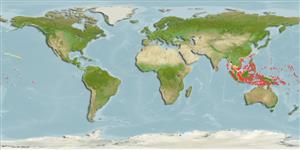Environment: milieu / climate zone / depth range / distribution range
Ökologie
seewasser riff-verbunden; tiefenbereich 20 - 50 m (Ref. 90102). Tropical; 30°N - 12°S
Western Pacific: southern Honshu, Japan to the Great Barrier Reef and New Caledonia. Reported from the Similan Islands in the Andaman Sea and Guam. Recently recorded from Tonga (Ref. 53797).
Size / Gewicht / Alter
Maturity: Lm ? range ? - ? cm
Max length : 60.0 cm SL Männchen/unbestimmt; (Ref. 48637)
Rückenflossenstacheln (insgesamt): 5; Rückenflossenweichstrahlen (insgesamt): 27-30; Afterflossenstacheln 2; Afterflossenweichstrahlen: 26 - 30. Lacks a horn, has numerous black close-set spots on the upper half of its body and tail, and is white ventrally. Body elongate, its depth 3.3 to 3.7 times in SL (Ref 9808).
Inhabits coastal to outer reef slopes subject to strong currents. Sometimes in large schools (Ref. 48637). Generally uncommon species found in steep outer reef drop-offs (Ref. 9710). Usually found in waters deeper than 6 m. Feeds on zooplanktons (Ref. 90102). Solitary or in groups (Ref. 37816).
Life cycle and mating behavior
Geschlechtsreife | Fortpflanzung | Ablaichen | Eier | Fecundity | Larven
Myers, R.F., 1991. Micronesian reef fishes. Second Ed. Coral Graphics, Barrigada, Guam. 298 p. (Ref. 1602)
IUCN Rote Liste Status (Ref. 130435)
Bedrohung für Menschen
Harmless
Nutzung durch Menschen
Fischereien: kommerziell; Aquarium: Kommerziell
Mehr Information
ReferenzenAquakulturAquakultur ProfilZuchtlinienGenetikElectrophoresesVererbbarkeitKrankheitenVerarbeitungNutrientsMass conversion
PartnerBilderStamps, Coins Misc.LauteCiguateraGeschwindigkeitSchwimmstilKiemenoberflächeOtolithsGehirngrößeSehfähigkeit
Tools
Zusatzinformationen
Download XML
Internet Quellen
Estimates based on models
Preferred temperature (Ref.
123201): 24.4 - 28.5, mean 27.6 °C (based on 73 cells).
Phylogenetic diversity index (Ref.
82804): PD
50 = 0.5000 [Uniqueness, from 0.5 = low to 2.0 = high].
Bayesian length-weight: a=0.01995 (0.00906 - 0.04395), b=3.00 (2.82 - 3.18), in cm total length, based on LWR estimates for this Genus-body shape (Ref.
93245).
Trophic level (Ref.
69278): 2.9 ±0.33 se; based on food items.
Widerstandsfähigkeit (Ref.
120179): mittel, Verdopplung der Population dauert 1,4 - 4,4 Jahre. (Preliminary K or Fecundity.).
Fishing Vulnerability (Ref.
59153): Moderate to high vulnerability (49 of 100).
Nutrients (Ref.
124155): Calcium = 32.3 [20.0, 58.7] mg/100g; Iron = 0.564 [0.286, 0.969] mg/100g; Protein = 18.8 [17.7, 19.8] %; Omega3 = 0.127 [0.079, 0.236] g/100g; Selenium = 34.6 [18.2, 62.7] μg/100g; VitaminA = 91.3 [32.2, 256.9] μg/100g; Zinc = 1.14 [0.79, 1.60] mg/100g (wet weight);
